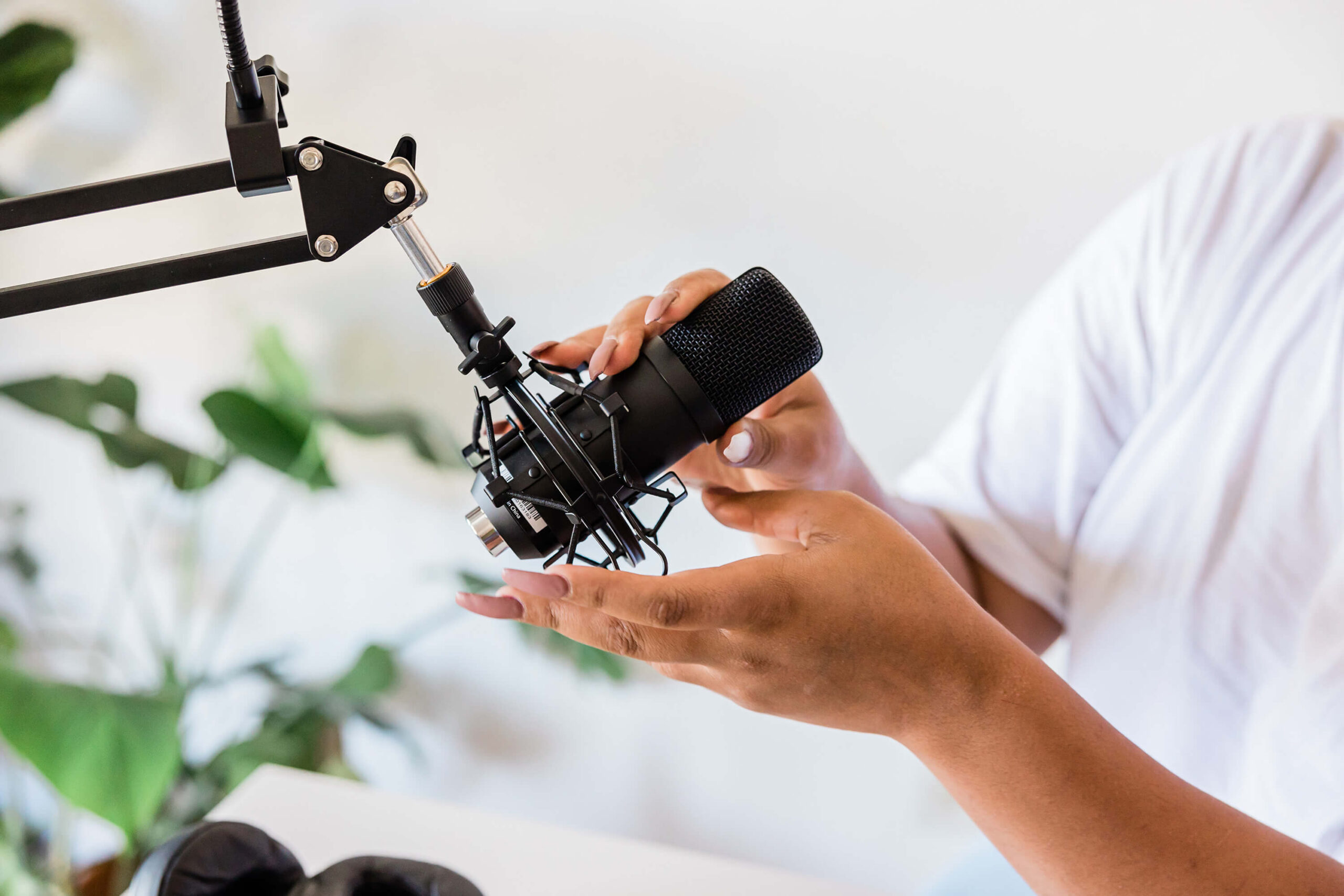Are you stuck trying to brainstorm new topics for your first (or next) podcast episodes? There are so many topics you could discuss, so it’s always smart to see if your content has a proven audience before you start recording.
Before you dive into research, I recommend starting with a judgment-free brainstorm.
What I like to do is set a timer for 5 minutes and see how many topics come to mind.
And don’t worry too much about how good your ideas are. The goal here is quantity, NOT quality.
To help guide your brainstorm, I reference a “download” in the episode. But after recording, I didn’t want to gate the content, so here are 10 prompts you can use to guide your brainstorm:
This isn’t a comprehensive list, but hopefully, it’ll jog your creativity and help you get your initial brainstorm list started.
As you start to brainstorm ideas, I recommend starting an Idea Bank where you can keep all episodes in one place. Otherwise, you’ll end up with a few ideas in your phone, a few on a Post-it, a few in a random spreadsheet…
…not the most helpful approach.
I also recommend having the option to capture ideas on your phone or on the go. So for example, although I’ve used almost all of these over the years, right now I save articles and ideas in Notion, so I have the Notion app on my phone in case ideas strike while I’m walking home from yoga.
If you’re interested, I put together a quick Google Sheet that could help you not just track your ideas, but also start ranking them or adding notes. Please feel free to add and edit your own columns: Copy my simple Idea Bank template
NOTE: This podcast was transcribed by a free AI tool called Otter. Please forgive any typos or errors.
Melissa Guller 0:00
What kinds of topics should you cover in your podcast episodes? It’s a big question. And there’s a lot more to it than just making things up as you go, or pulling a topic out of thin air.
So in this episode, I’ll share why certain episode topics are stronger than others. And I’ll talk about the difference between evergreen, seasonal and trending content.
After that, I’ll talk about how to start with a brainstorm. And then take those ideas into research to find 10 to 20 proven ideas that your audience will really love.
It’s all coming up in today’s podcasting lesson here on Wit & Wire.
Announcer 0:43
Welcome to Wit & Wire, the podcast that takes you behind the scenes with podcasters and industry experts to help you start and scale a binge worthy podcast of your own. here’s your host, Melissa Guller.
Melissa Guller 0:58
Hey everyone, I’m Melissa, and I want to first say thank you to three of my listeners for suggesting this topic. So, a big shout out to Wit & Wire listeners, Bonnie, Kiru, and Dana. You guys rock. And to give all of you a small spoiler for this episode, asking my listeners for feedback is one of my favorite ways to find great topics. So, again, a huge thank you to all three of you for inspiring this episode.
Melissa Guller 1:27
I know that finding the right topics to discuss is something that often holds podcasters back from either starting your show in the first place, or continuing if you feel like you’ve hit a plateau.
Melissa Guller 1:39
It can feel so stressful wondering what you’re going to work on next. And that’s why one of my big goals for today is to make the whole research process feel a lot easier. And to help you find the right ideas for your next 10 to 20 episodes that you feel really confident about.
Melissa Guller 1:57
You may have noticed I’m not just talking about one episode today, as podcasters producing great content is the core of what we do. And that’s why I want to give you the tools to come up with so many ideas that you’ll have the ability to pick and choose instead of feeling stuck, or like there’s nothing left to talk about.
Melissa Guller 2:22
Here’s a pro tip right off the bat. The key to a great topic isn’t necessarily doing something that’s never been done before.
Instead, it’s about finding your voice on a topic that, in fact, people probably do already know and care about or might be interested in.
Because a great topic isn’t just about you. It’s about your listener. And your goal is maybe to share knowledge or to impart skills. And even if you don’t have a skill oriented podcast, it could just be about sharing them, or entertaining. But at the end of the day, that topic needs to be something that your listener cares about.
Melissa Guller 3:08
On the other hand, there’s one major thing to avoid. And that’s my this, my that, making it all about you.
You can and you absolutely should talk about yourself. But what you’ll want to do is find a way to relate your life and your stories to your listener. Otherwise, you’ll lose them.
Imagine sitting down for dinner with a guest who just talks about themselves for the whole time. And it starts to get old really quickly. And I don’t want your podcast to feel like that. So always make sure that you’re thinking about your listener, and that’s if nothing else, the biggest takeaway I can impart in this episode.
Melissa Guller 3:52
Now when it comes to content, there are three pretty distinct types that you’ll want to think about.
First is evergreen content. And evergreen means that if somebody listens in six months or a year from now, it’ll still be relevant. And most content can be made evergreen. Even if you think about, you know, telling stories or teaching people new skills, or sharing, just awareness over a topic, most of those things can be made evergreen, and this episode is an example of evergreen content.
Another type, though, is seasonal content. And seasonal is different from evergreen because although it comes back, it only does so occasionally. So anything around Black Friday is the classic example of seasonal content. It happens once a year at a very specific time of year. And I would also say just as the name implies, there’s some content that’s going to be a better fit during the summer versus winter or during different times of the year.
The last type of content is trending content. And this is much different from evergreen and seasonal, because trending content is what’s happening right now. So this can be related to the news, politics, something going on on a global scale, or even on a smaller scale, maybe it’s just something that’s going on in your community. So as an example, with my podcast, I could talk about things that are trending in podcasting. So for example, Spotify is testing out video podcasts on their platform that’s going on right now in early May 2020. And who knows what will come of that. But if I were to do a full episode about that, it would very much be trending content.
The other very global, very major trend going on right now. I hate to call it a trend. It’s not like a fashion trend, but COVID-19 is certainly a trending topic.
Trending just means it’s going on right now, it doesn’t mean like bell bottoms are back in season, you know. So those are the three types of content, evergreen, seasonal, and trending. And unless you’re doing a news or a pop culture show, it’s likely that you’ll want the majority of your content to be evergreen.
However, as we’ll talk about a bit later on, mixing in seasonal and trending content is a really great strategy to keep your content fresh. But let’s not get ahead of ourselves. First, we need to talk about how to find great topics.
Melissa Guller 6:41
Let me just start by saying this. There’s no right or wrong way to choose your episode topics. And you’ll probably find that you have your own preferences as you continue to produce more and more episodes. So my goal for today is just to walk you through the way that I approach finding more episodes for my podcasts, because if nothing else, I’d love to help you expand the possibilities for your own ideas. And I think there are two very different approaches that we’re going to take. And I would recommend trying both.
First, I always recommend that you start with a brainstorm. So sit down, set a timer for five to 10 minutes, and just see what you can come up with. And try not to stop and try not to judge the ideas. And you won’t end up using all of these ideas later. And that’s totally fine. But usually, the first ideas that we come up with might be pretty good. But it’s not until you list out 1020 even 30 different ideas that you start to get into the real creative nuggets that nobody else is doing or that you haven’t thought about yet. And so that’s a big part of why brainstorming is so powerful. It just lets you explore your own mind a little bit more.
Melissa Guller 7:59
Now, as you’re brainstorming, there are some prompts that you can try. And I’ll include a download in the show notes at witandwire.com/4, if you want to download a little worksheet.
Melissa Guller 8:13
So while you’re brainstorming first, maybe you imagine, what are you curious about? Or what do you want to try?
Being a podcaster is such a fun opportunity to try and research new things. So that’s a great first place to start.
Another great prompt is, what do you find interesting? or What does your listener find interesting. This could be something that you already know quite a bit about. Or maybe it’s something you only know, a small piece of, and now you have an opportunity to build your own knowledge while you help others.
This could also be something that’s just fun for you, like pop culture or chatting with friends so interesting. could mean Oh, let me do some research or it could be, oh my god, can you believe that thing that happened last week? Let’s talk about it.
Melissa Guller 9:06
Now some other prompts move in a little bit of a different direction. You can ask, what are some things that you believe? Or you don’t believe? Or what do you think that a lot of people don’t understand or get wrong?
Being a podcaster gives you a platform to share different perspectives. And so if you feel that you have a perspective, or you have maybe a guest with a unique perspective that’s worth sharing. That can be a great brainstorm too.
Speaking of guests, if you are doing an interview style show, it’s a great starting point to brainstorm not just people you could interview, but maybe types of people. So that could mean job description. Maybe you want to interview graphic designers, or maybe you want to interview somebody who’s been on a reality TV show. But you could also just interview people who have a family member who’s been affected by cancer or a mom or any just word that they might use to describe themselves, it doesn’t have to be a job description. So as you’re starting to brainstorm, think about, again, not just specific people, maybe you already have a few in mind, maybe you don’t. But you can also just list out types of people or people with certain expertise or life experiences.
Melissa Guller 10:21
Lastly, this moves a little bit into the realm of research. But ask yourself, what have other blogs, podcasts, YouTube channels or social media accounts done, that you really liked? Maybe you saw a post on Instagram, and it was really interesting to you whether or not it sounded familiar or not. Like maybe you didn’t know a ton about the topic, but you thought, Oh, I could have offered five different tips than they did. And that could spark a great episode. Always keep your eyes peeled on what else is going on. And you don’t want to copy it directly, of course, but there’s a big
Difference between the topic and your take on it. Like if I asked five different podcasters to give their top three tips on starting a podcast, their lists would all be very different. So don’t hesitate to use a topic that’s been used before. It’s all about your perspective.
Melissa Guller 11:18
Now, before we do get into the research, you can also start asking people, ask your friends, your clients, co workers, your Instagram followers, and of course, your podcast listeners, my favorites. And what I’d say is just remember to really value the people who are actually your ideal podcast listeners. Because maybe your coworker is a good example. You value their opinion a ton. But if your podcast isn’t related to the work that you do together, and they probably wouldn’t ever tune into your podcast, then you can get their thoughts, but I would just take it with a grain of salt because at the end of the day, you’re gonna have the best gut feeling on which topics to pursue.
If you tried the brainstorm, you may realize that you already have so much content to work with. And maybe you have the question, well, which of these topics are the strongest. And that’s where I like to bring in the research phase.
Melissa Guller 12:22
There are three different mindsets that I find really helpful to tap into, when I go down to narrow my list from a huge set of ideas down to the 10 or 20 that I really want to pursue.
The first is to think like a listener. The second is to think like a marketer. And the third is to think like a reporter. And I’m going to go through each one, one by one.
First up, I want you to think like your listener.
And specifically, I want you to imagine…what are they searching for?
Because a big way that people are going to find your podcast is through searching. Maybe they’re searching via friends and asking friends for tips and recommendations. And then the friend will say, Oh, you got to check out this podcast. But maybe they’re googling. Maybe they’re searching on a social media platform. And in order to get your podcast in front of them, you need to figure out what they’re searching for so that you come up in those results. So imagine things like, what are their pain points? What are they trying to learn? What are they curious about or who are their favorite people.
When you put yourself in your listeners shoes, that’s where some of your very best episodes are going to come from. Because your existing listeners will love you, because you’re putting out content that they’re really enjoying. And it’ll help new listeners find you either because they’ll search for something and you’ll come up
Even if they come across your podcast somehow, and then they see this episode topic that really speaks to them. That’s how you’re going to find a new listener. So I really want you to put yourself in your listeners shoes are very cute shoes, and think like them. And specifically think, as they use Google. Imagine literally what are they searching for, because that’s a great place to start.
Melissa Guller 14:26
Now related to thinking like a listener, is thinking like a marketer. So the listener has hopes and dreams and fears and wants to laugh and loves the bachelor but also wants to learn how to dice an onion perfectly. But a marketer is thinking, Okay, well, what keywords are popular, so it’s not just what one person is searching for. I want to know how many people are searching for certain keywords. And that’s why the same way that you can use keyword research for blogs. You absolutely can use keyword research for podcasts.
A couple of other ways to think like a marketer. First, I might ask, what episodes are popular or interesting on similar shows. And you can see some of that in Apple podcasts. If you go to other podcasts and you look on the right, you can see there’s literally a measure of popularity. So I might look at another show and think, Hmm, this episode about this topic is very popular. Let me find a way to put my own spin on that topic. You can also take a look and see which guests are appearing on similar podcasts and invite them to your show. Because if they already said yes to another podcast that’s similar to yours in maybe topic or size or audience. That’s a great indicator that maybe they want to come on your show. And it also tells you that they know how to be on a podcast, which is great.
Lastly, if I were to think like a marketer put my marketing hat on I would also take a look at blogs related to my topic. And we mentioned this briefly before, but I would take a look and see what are their top posts? And same thing for YouTube channels, I would find YouTube channels that are similar to mine. And I would see okay, what are their most popular videos or what’s getting the most views? thinking like a marketer is great because it can help put you in front of larger audiences, if you’re choosing topics that already are proven to appeal to larger audiences.
Melissa Guller 16:30
Now, we’ve covered the first two mindsets thinking like a listener and thinking like a marketer. And that brings up thinking like a reporter.
Back in the beginning of the episode, we talked about the difference between evergreen content seasonal and trending. And if I were to think like a reporter, I would definitely ask myself, what is trending? So I’m not just talking about the news, although that’s important. I’m thinking about big picture news, I’m thinking about industry news, like what’s going on in, as I mentioned before, like podcasting, I’m always keeping an eye on what’s going on in the podcasting world.
Beyond that, though, what newly released books, movies or tv shows have just come out, because maybe I want to talk about those. Or maybe I want to even see if I can get one of those authors on my podcast.
Another area where things are trending is on social media. This is where things are literally hashtag trending. And maybe you want to create content, that’ll get you in on that hashtag. And then even like, in memes on Tick Tock like always keep an eye on what people are up to, because you never know which topic could be a great fit for your show.
We also briefly touched on current events like obviously in the climate of may 2020. COVID-19 is absolutely huge. And a lot of people are turning to resources everywhere. So help them out in different ways. And so that’s hugely important. And for a lot of businesses and podcasts talking about COVID-19 is going to be the right choice. It’s just about how you approach it and what your particular either perspective is or way to help could be.
Melissa Guller 18:17
And then lastly, I know I mentioned the movies and the TV shows, but always keep an eye on not just what’s newly released, but also what’s coming out soon, because that’ll help you plan a little bit ahead. And then when it is released, maybe your podcast goes live, the same week that a book went live if you were able to get an in with an author of a slightly smaller published book. So those are all the ways I might think like a reporter. And to circle back to this evergreen concept. I do recommend that most of your topics are evergreen, because it’ll help your podcasts live longer. And you’ll be surprised by how many people find your podcast later.
Go back to old episodes, I have episodes that are two years old that are still getting new downloads from new listeners. And that’s why having evergreen content is so valuable. But on the other hand, trending topics can’t be ignored. Because what’s great about a trending topic is that people are searching for it. And search results drive listens. So I think it’s important to have a mix of the two. Always have more evergreen content unless your podcast is about pop culture or news. But definitely don’t shy away from the trending topics.
Melissa Guller 19:34
To quickly recap the mindsets, you want to think like a listener to imagine what your ideal audience is looking for. You want to think like a marketer to see what’s popular in searches, other podcasts and other blogs. And you want to think like a reporter to ask what’s trending now that people want more information about to help you get that mix of evergreen and trending content from your audience.
Melissa Guller 20:05
As we start to wrap up this episode, I want to leave you with some tools of the trade. Because maybe when I mentioned keyword research or keeping track of your ideas, you wondered how you might do that. So if you are interested in keyword research tools, I recommend our h refs. And Uber suggests, and I’ll put links to those in the show notes. The trick to keywords is that you want to find something that’s popular, and that’s getting traffic, but not so popular that everyone is trying to rank for it. And by the way, if you’re new to keyword research, a keyword can actually be more than one word, it could be a couple of words or a short phrase. So as an example, the key word for this episode is brainstorm topics. So I did a bit of research found that that’s a term that people are searching for in Google, and that’s the one that I went with.
And even if you don’t want to deal with fancy tools, you can also just google something yourself and scroll to the bottom of the page and see the related topics that they recommend on the bottom. Because those are usually versions of what you’ve searched for, that other people are searching for. So that’s a great place to look.
Another tool is answer the public. And if you search for a different word or term, you’ll see different versions of questions getting asked. So again, I’ll put links to everything in the show notes, and I’ll share that URL in just a minute.
Melissa Guller 21:32
The other recommendation I want to leave you with is to create an idea bank, or a place where you capture all of your great ideas. You never know when inspiration will strike. And you could keep a note on your phone or a physical notebook. Or maybe you want to use an online option like a spreadsheet or a task manager like Asana my fav and what I personally like about a spreadsheet is that you can start to give your ideas rankings, take notes.
So as an example, maybe you list out a bunch of things, and then you start to rank them based on keyword research or, importantly, like your own interest in the topic that matters a ton. There’s no right or wrong way to rank your list. But I think that keeping track and an online system whether it’s a spreadsheet or a task manager, can be a great option. And that’s why I’ve actually created a really easy free Google Sheet that you can download in the show notes if you want to give it a go.
Melissa Guller 22:33
To wrap up, I just want to share a quick recap.
We talked about the importance of your listener and how at the end of the day, your goal is to find something that inspires, entertains or informs them.
We also talked about the difference between evergreen seasonal and trending content and why it can be helpful to have a mix instead of only doing evergreen or only trending.
Lastly, we talked about brainstorming first just to get your ideas out on a page. And then we learned how to think like a listener, like a marketer, and like a reporter. And I recommended that you start keeping an episode idea bank somewhere since you never know when inspiration will strike. And it’s a great idea to keep all of your ideas in one place.
Now, ultimately, though, it all just comes down to this. As long as you have your listeners best interests at heart, you’ll be just fine.
Melissa Guller 23:32
Thank you so much for joining me this week. To view the complete show notes and a recap of today’s lesson including the references, the tools and the freebie I mentioned. You can visit witandwire.com/4.
Now, before you go, I hope you’ll subscribe to the podcast so you can receive new episodes right when they’re released. You can either Subscribe for right now in the app you’re using to listen to this episode. Or you can sign up for free email alerts at witandwire.com/4.
Lastly, true to the theme of this episode, I’d love to hear from you. If there’s something that you want to learn more about, I have a short poll in the show notes at witandwire.com/4. And I’m really excited to share some of the top requests in upcoming episodes very soon.
Melissa Guller 24:21
Thank you again for joining me, Melissa Guller In this episode of Wit & Wire, I’ll see you next time, podcasters!




